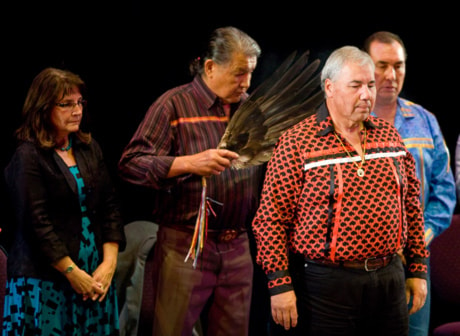GATINEAU, Que. — An emotional Justice Murray Sinclair spoke openly of his hopes — and fears — as new head of the commission tasked with opening then closing the wounds of abuse at native residential schools.
The Manitoba judge from the St. Peter’s First Nation was named last month to lead the revamped Truth and Reconciliation Commission (TRC).
It got off to “a troubled start,” he said Thursday as native elders offered sacred ceremonies of support at the aboriginal-inspired Museum of Civilization.
“I am conscious of the fact that within one generation we will lose all the people who worked in the schools.” In two generations, about 75,000 surviving former students will also be gone.
“We have to get going,” Sinclair said after being wrapped in a star blanket symbolizing protection, and drawing smoke from a ceremonial pipe that he passed to new co-commissioners Wilton (Willie) Littlechild and Marie Wilson.
They are all fresh to the job after internal power struggles derailed the commission last October under Justice Harry LaForme.
It had only been named the previous June. It had not yet held a single event to collect precious testimony on how the now closed schools were run by the Catholic, Anglican, Presbyterian and United churches.
About four former students die each day, says the Assembly of First Nations.
“We have an awful lot riding on the work that we do — and I know that,” Sinclair said. The commission will hold seven events across Canada and will produce a comprehensive report and history on the school system by 2014.
The $60-million commission is part of a landmark compensation deal, one of the largest in Canadian history, that’s expected to top $4 billion.
Sinclair will hear graphic details of rampant and at times horrific cases of sexual and physical abuse. But he said he also expects to hear less reported accounts of compassionate teachers who tried to protect their young charges, and who are still fondly remembered to this day.
Sinclair fought tears as he recalled the hopes he carried of the grandmother who raised him after his mother died. He spoke of the aunts and uncles who were inspired when he became the first in the family to graduate from university. He later became the first native judge in Manitoba in 1988.
But with such hope comes the fear that he compared to the birth of his first child, he said.
Michael Wernick, deputy minister of Indian Affairs, thanked former Supreme Court of Canada judge Frank Iacobucci for sorting out the legal mess created when LaForme quit last October.
He accused his co-commissioners of undercutting his authority — something Claudette Dumont-Smith and Jane Brewin Morley denied. Both women wound up resigning to allow a fresh start.
Littlechild, a lawyer from the Ermineskin First Nation near Hobbema, said the new commission is “a good team.”
Wilson worked as a journalist and broadcaster for years before becoming a regional director of CBC North.
About 150,000 First Nation, Inuit and Metis children were forced to attend the government schools over much of the last century. The last closed outside Regina in 1996.
